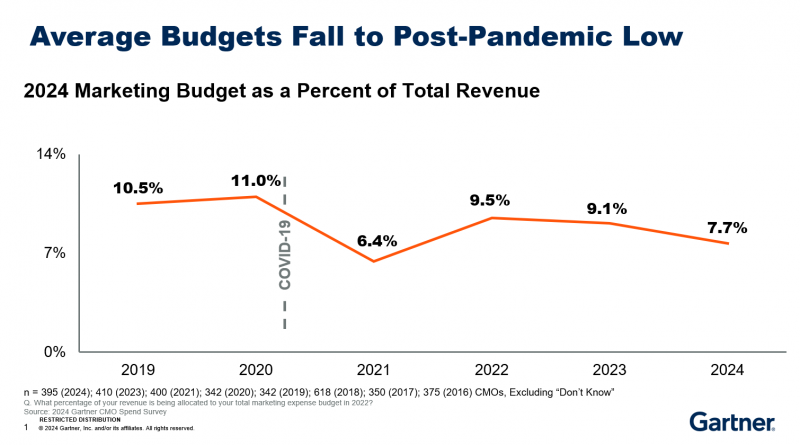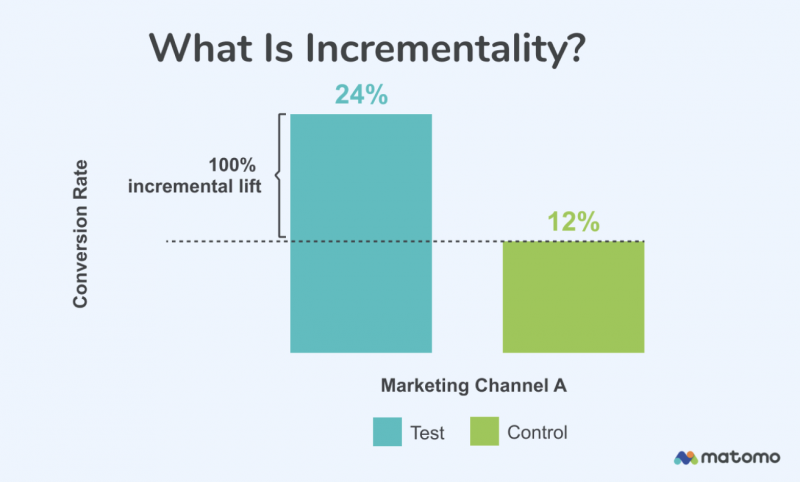Simply put, Incrementality is a method for measuring the true value of marketing efforts. The Interactive Advertising Bureau (IAB) defines it as quantifying the causal impact of marketing strategies on sales and other outcomes while eliminating external influences, ensuring that results are directly attributed to advertising efforts.
Incrementality: A Key Trend Every Marketer Must Know
“Incrementality” has long been a hot topic in the marketing and retail media industries, increasingly becoming a crucial metric for advertisers evaluating campaign performance. While the concept itself is not new—marketers have always sought to measure the incremental impact of advertising—its significance has grown as global economic downturns and market instability have led to tighter marketing budgets.
With brands and advertisers scrutinizing every dollar spent, they are more focused than ever on ensuring their investments generate real value. According to Gartner’s 2024 Annual Marketing Spend Survey, which interviewed 395 CMOs from major brands, overall marketing budgets as a percentage of company revenue dropped from 9.1% in 2023 to 7.7% in 2024—highlighting the increasing pressure to maximize efficiency and ROI.
 –
–
Many Retail Media Networks (RMNs) have started providing insights on Incrementality, demonstrating its importance to advertisers. Ali Miller, VP of Ads Product at Instacart, describes Incrementality as “the gold standard for measuring the true impact of advertising on sales.”
–
What Is Incrementality?
Simply put, Incrementality is a method for measuring the true value of marketing efforts. The Interactive Advertising Bureau (IAB) defines it as quantifying the causal impact of marketing strategies on sales and other outcomes while eliminating external influences, ensuring that results are directly attributed to advertising efforts.
Jeff Bustos from IAB further explains that the core of Incrementality is “isolating media spend”, allowing marketers to clearly assess the actual impact of ad investments on sales, ROAS (Return on Ad Spend), or other conversion metrics.
In simpler terms, Incrementality determines whether ads drive additional sales or engagement. The formula is straightforward:
📊 (Test Conversion Rate – Control Conversion Rate) / Test Conversion Rate = Incrementality
This means comparing performance without ads vs. with ads—the difference reveals the true incremental value of advertising.

–
What Is Attribution Analysis?
Attribution Analysis is the process of assigning credit for a conversion (e.g., a purchase) to specific marketing touchpoints. While Incrementality focuses on measuring an ad campaign’s overall impact on revenue, Attribution Analysis identifies which specific channels or tactics contributed to the sale.
Example:
Imagine you launch a marketing campaign to promote a new product using multiple strategies:
- Paid ads on Facebook & Instagram
- A blog post explaining the product’s features
- Organic social media posts on Instagram & TikTok
- An email campaign building excitement before the launch
- Limited-time discount promotions via SMS & LINE
After launch, the campaign generates NT$1,000,000 in revenue. The key question is: Which channel deserves the most credit?
- Did Facebook ads drive initial awareness?
- Did Instagram attract followers who later signed up for emails?
- Was it the email campaign that reminded potential buyers about the promotion?
- Did social media posts reinforce brand recall?
- Or did the SMS/LINE promotions with limited-time discounts directly trigger purchases?
Attribution Analysis helps answer this question by accurately distributing credit to the channels that influenced the conversion.
Maximizing Incrementality with Attribution Analysis
Incrementality and Attribution Analysis are not competing methodologies; rather, they complement each other and should be used together for maximum impact. By integrating both, marketers gain deeper insights into which campaigns, channels, and strategies drive real business growth. This combination allows brands to identify the most effective tactics, ultimately maximizing marketing ROI.
–
Why Is Incrementality Important?
Incrementality not only helps advertisers quantify the true value of their campaigns but also enables Retail Media Networks (RMNs) to showcase their platform’s effectiveness. In a time of tight marketing budgets, having accurate performance measurement is key to gaining advertisers’ trust. If you haven’t incorporated Incrementality into your marketing strategy, now is the time—it’s becoming a core metric for marketing success.
–
The Advantages of Measuring Incrementality
Incrementality is often called the “North Star” of marketing measurement, as it provides a clear view of an ad campaign’s true impact across channels. Here are its key benefits:
1.Optimizing Ad Spend
By identifying which campaigns truly drive additional sales, brands can allocate budgets more efficiently—focusing on high-impact activities.
2.Understanding True Campaign Impact
Incrementality measures more than just clicks and conversions—it evaluates how ads influence customer behavior, providing a clearer picture of real business impact.
3.Eliminating Wasted Spend
It helps distinguish organic buyers from ad-driven buyers, allowing brands to reduce unnecessary ad spend and focus on effective investments.
4.Scaling Winning Strategies
By identifying successful campaigns, brands can replicate and expand high-performing initiatives to maximize returns.
–
How to Measure Incrementality? Let the Data Speak
Measuring Incrementality is both critical and complex due to varied methodologies, formulas, and data sources. No single measurement approach applies universally, and different methods may yield different results. Publicis Chief Commerce Strategy Officer Jason Goldberg highlights this challenge: “Marketers and CFOs want to compare results ‘apples to apples,’ but in reality, that’s impossible.” This underscores the difficulty of standardizing Incrementality measurement.
–
Best Practices for Measuring Incrementality
To improve measurement accuracy, the IAB (Interactive Advertising Bureau) recommends the following:
1.Choose the Right Methodology
Different marketing campaigns require different testing approaches, such as:
- A/B Testing
- Control Group Testing
- Predictive Modeling
Ensuring the right methodology aligns with your goals enhances data accuracy.
2.Define Your Data Needs
A robust Incrementality analysis requires comprehensive data, including:
- Sales data
- Ad spend data
- Customer behavior insights
Clearly defining data parameters prevents misleading results.
3.Maintain Data Transparency
Advertisers and stakeholders must trust the Incrementality results. Transparent data sources and methodologies build confidence and credibility.
–
Why Are Advertisers Prioritizing Incrementality?
Incrementality is becoming a key metric because it reveals the real impact of RMN campaigns, beyond just surface-level performance indicators.
According to the Association of National Advertisers (ANA): 42% of advertisers remain cautious about investing in RMNs, mainly due to lack of standardized measurement and transparency issues.
–
Incrementality vs. ROAS: Why It Matters More
Unlike Return on Ad Spend (ROAS), which measures total revenue vs. ad spend, Incrementality focuses solely on additional revenue generated by ads. High ROAS can be misleading—some sales would have happened anyway without ads. Incrementality provides a more accurate measurement of an ad’s true effectiveness. Moti Radomski, VP of Product at Skai, explains: “Brands frequently ask: ‘How do we know this sale wouldn’t have happened anyway?’”
For example, if a consumer sees a YouTube ad but doesn’t click, then later makes a purchase because they already planned to buy—the ad shouldn’t receive full credit. Survey Data: 56% of advertisers use incremental sales as a KPI for RMNs, second only to ROI/ROAS (58%).
–
Incrementality in a Challenging Economy
During economic downturns, marketers face stricter budget scrutiny. Publicis’ Jason Goldberg explains: “Incrementality is highly valued because it helps advertisers eliminate media waste, ensuring every dollar is spent on real business impact.”
How Incrementality Helps Advertisers:
- Provides accurate insights – Distinguishes ad-driven sales from organic sales.
- Informs smarter investment decisions – Directs funds toward high-performing campaigns.
- Enhances transparency – Reduces reliance on ambiguous or misleading data.
-\
How Retailers Can Improve Incrementality
Although external factors like market trends and competition impact Incrementality, retailers can take actionable steps to enhance their results:
Offer Unique Ad Formats
Eye-catching native ads and video placements can drive stronger engagement compared to standard ad formats.
Optimize Audience Segmentation
By analyzing incremental traffic, brands can better understand consumer behaviors across different channels.
Leverage Precision Targeting
Delivering highly relevant messages to the right audience increases conversion rates and long-term customer value.
Manage Campaign Frequency
Optimizing ad exposure frequency ensures higher engagement without causing ad fatigue.
–
Final Thoughts
Incrementality is more than just data analysis—it’s the science behind effective marketing.
By combining Incrementality and Attribution Analysis, marketers can:
✅ Maximize ad efficiency
✅ Eliminate wasted spend
✅ Make smarter, data-driven decisions
